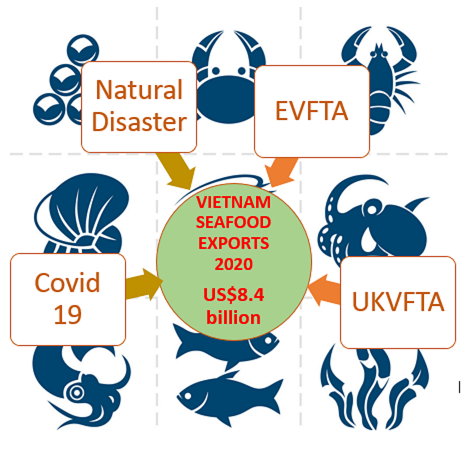(seafood.vasep.com.vn) The 2020 was a turbulent year for the world economy with many nations suffering tremendous losses due to the COVID-19 pandemic. Vietnam has been less affected by the pandemic thanks to extraordinary efforts of the industry. Notwithstanding, everything from life to socio-economic, education, and national security has undergone many months of upsetting. Vietnam's seafood industry has been affected by various issues. Continued difficulties from key export markets and natural disasters have caused both farmers and businesses to worry to fight for "survival". At the end of the year, the total seafood export value of Vietnam reached 8.41 billion USD, slightly down 1.9% compared to 2019. This result reflects the tireless efforts of seafood enterprises in the light of the pandemic crisis.

Vasep's bulletin reviews the five most highlight events of Vietnam's fisheries industry in 2020
1. Vietnamese seafood was a wobble in 2020 due to the Covid-19
Vietnam's seafood export activities go through the "crisis" most in the first quarter of 2020 when the corona epidemic broke out. The percentage of orders delivered under signed contracts only accounted for 30-50%. Since April 2020 when the pandemic spread out over the EU, many countries had to issue orders for lockdown, border closures, and social distancing, a series of customers demanded to delay delivery or cancel orders. As a result, ships were delayed or canceled because shipping lines cut trips, change the itinerary and port of destination, etc., causing a lack of containers. Until the beginning of quarter 4/2020, export activities to major markets gradually stabilized. For a whole year, seafood export enterprises struggled with the problem of minimizing damage, ensuring survival, and sharing difficulties with their partners, adapting to change in consumtion habits in import markets, turning challenges into opportunities.
2. Pangasius exports lower than expectations
VASEP gave an optimistic forecast at the end of 2019 that the export of Vietnamese pangasius to China, the US, and ASEAN in 2020 could achieve positive double-digit growth. However, since the beginning of the year, when the seafood processing factories of China - Hong Kong took a long Lunar New Year holiday due to Covid-19, the export of pangasius to this market was also interrupted. China-Hong Kong has been the largest pangasius export market of Vietnamese enterprises. Entering the second quarter of 2020, the production of Chinese factories returned, import-export activities also returned when Beijing did not record any cases of COVID-19 infection for 56 consecutive days. However, pangasius exports to China continued to slow down and were congested soon after less than one month because the Chinese were fear of coronavirus spreading from imported seafood to the community. In 2020, the total value of pangasius exports to China - Hong Kong (the largest export market) reached 514.8 million USD, down 22.3% over the period in 2019. In other major importers, the export value also decreased: the US slumped by 14.4%; ASEAN and the EU fell by 31.3% and 31.1% compared to 2019, respectively.
3. FTAs with EU and UK are driving force to boost seafood exports to markets
The EVFTA Agreement took effect on August 1st, 2020 with 220 seafood items having the base tax rate of 0-22 reduced to 0% from this date. In particular, several processed products with a high basic tax rate of 20% will be reduced that tariff to 0% immediately. By the end of 2020, the EU was the 4th largest seafood export market of Vietnam (after the US, Japan, China - Hong Kong). After nearly half a year of this agreement came to force in the light of Covid-19 still having a severe impact on most of the European economies, seafood exports to the EU rose slightly in some commodities such as shrimp roared 6.1%; tuna lifted by 2.4%.
In 2020, seafood exports to the UK market were active. In which, the UK market was the brightest spot on the scene of Vietnamese pangasius exports. At the end of the year, the total seafood export value to this market reached 344.6 million USD, up 22.8%. In particular, the export value of shrimp to the UK rose by 20.1% and that of pangasius to the UK jumped by 30.1% compared to 2019. If the Covid-19 epidemic is better controlled in the coming time, it is expected that seafood exports to the EU and UK will gradually improve and grow better.
4. Heavy floods in the Central region affect seafood processing factories
There were loads of natural disasters and unusual epidemics this year. Of which five storms and tropical depressions occurred continuously in the East Sea between September to November leading to heavy rains for many days in the central provinces. High floods cause flooding, dividing many residential areas. Besides, traffic is isolated, all fishing and processing activities of fishermen, seafood processing factories of the Central have stopped working. As a result, thousands of hectares of aquaculture were devasted.
5. Shrimp export is turned "challenges" into "opportunities"
In 2020, shrimp export value alone reached 3.73 billion USD, accounting for 44.3% of the total export value of the whole sector, up 11% compared to 2019.
Early 2020, the COVID-19 outbreak has had a significant impact on global shrimp production and trade, leading to oversupply and low prices. Notwithstanding, the Vietnamese shrimp industry also gets opportunities as some major shrimp suppliers in the world such as Ecuador, India, Indonesia, Thailand are severely damaged by disease, and their domestic production was delayed. The shrimp enterprises of these countries have still been struggling to cope with the pandemic so far. Vietnam shrimp is, therefore, more competitive over the product of these countries.